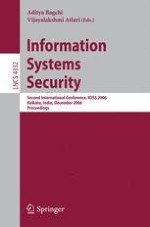2006 | Buch
Information Systems Security
Second International Conference, ICISS 2006, Kolkata, India, December 19-21, 2006. Proceedings
herausgegeben von: Aditya Bagchi, Vijayalakshmi Atluri
Verlag: Springer Berlin Heidelberg
Buchreihe : Lecture Notes in Computer Science
